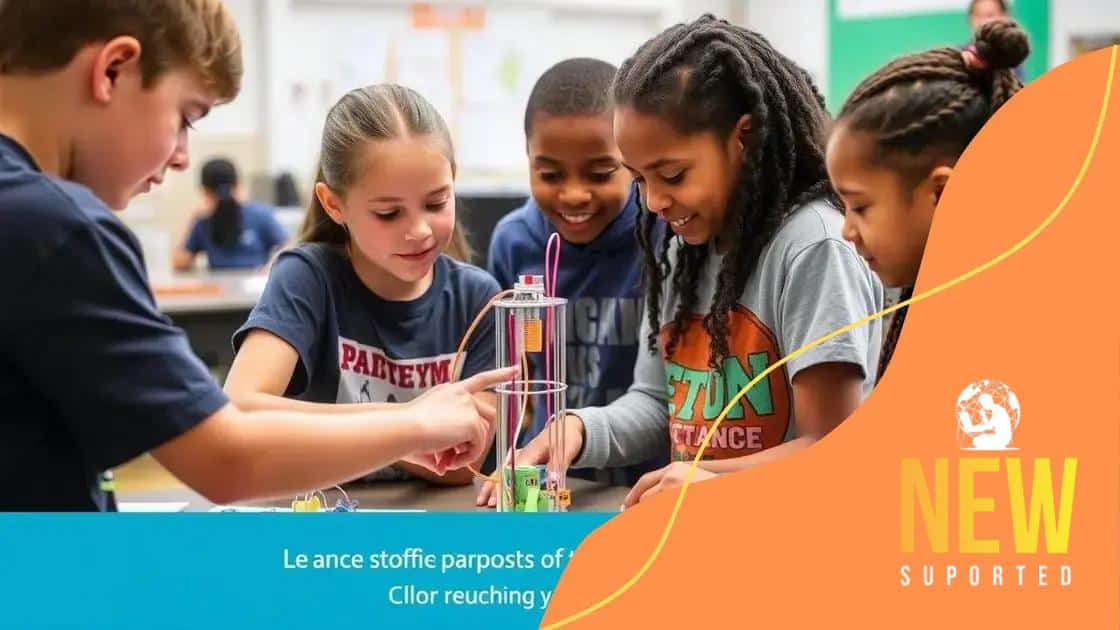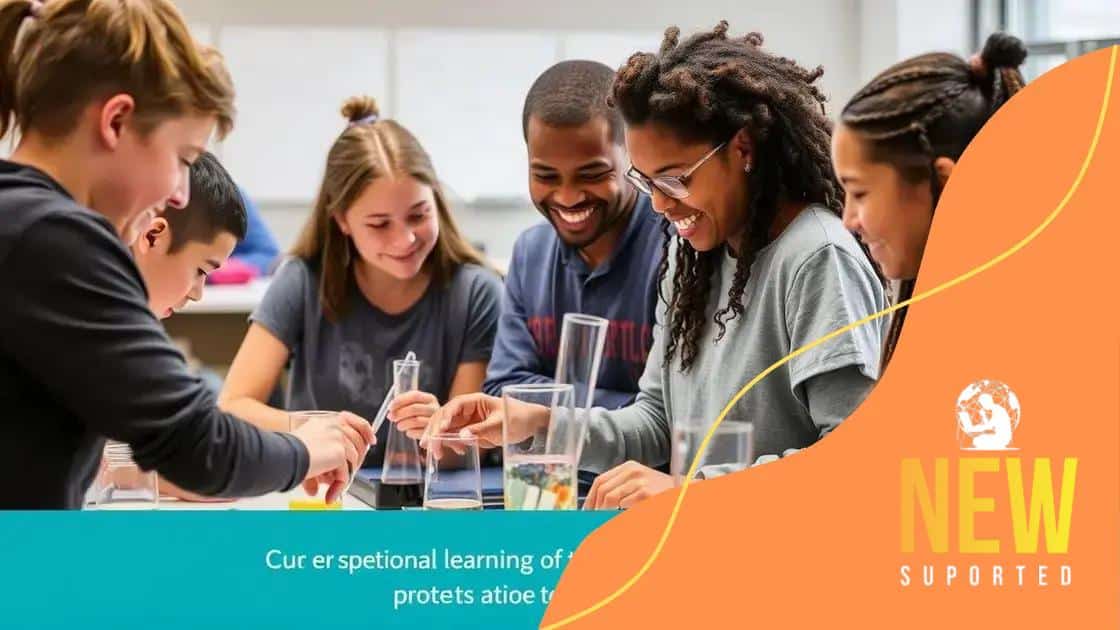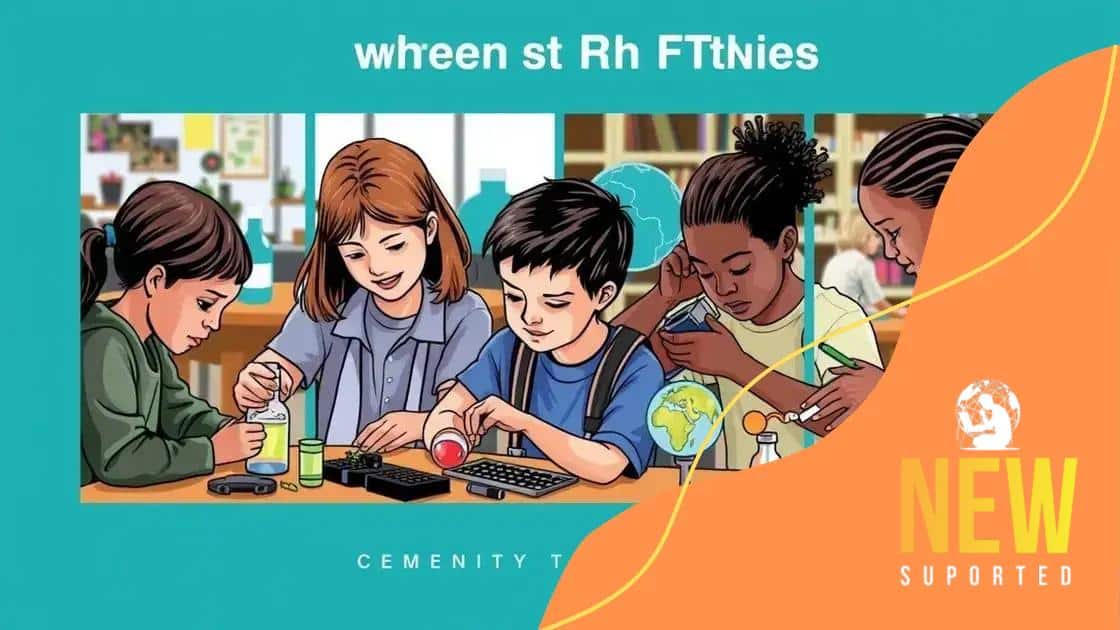The importance of hands-on learning in STEM fields

Hands-on learning in STEM fields enhances student engagement, critical thinking, and teamwork by allowing students to apply theoretical concepts through practical experiences and real-world problem-solving activities.
The importance of hands-on learning in STEM fields cannot be overstated. Imagine a classroom where students actively engage with concepts, rather than just memorizing theories. Isn’t that a more effective way to learn?
Understanding hands-on learning in STEM
Hands-on learning is crucial in STEM education. It enables students to actively engage with concepts, making learning more effective and enjoyable. Through practical experiences, students can develop essential skills that are valuable in real-world situations.
The Role of Hands-On Learning
Incorporating hands-on activities allows students to explore concepts deeply. When students manipulate materials or work on projects, they better understand abstract ideas. This approach not only enhances their grasp of STEM principles but also builds their confidence.
Benefits of Engaging with Real-World Problems
When students engage with real-world problems, it connects their learning to everyday life. This practical approach boosts engagement and helps them see the relevance of their studies.
- Promotes critical thinking skills
- Encourages teamwork and collaboration
- Enhances problem-solving abilities
Through hands-on experiences, students develop a sense of ownership over their learning. They become creators rather than passive recipients of information. This transformation is crucial in STEM fields, where innovation is key.
Moreover, hands-on learning accommodates various learning styles. Visual learners benefit from seeing concepts in action, while kinesthetic learners thrive on physical involvement. This inclusive approach ensures that every student has the opportunity to succeed.
Applications in the Classroom
Teachers can utilize different strategies to implement hands-on learning. From science experiments to coding projects, the possibilities are endless. Incorporating technology can further enrich these experiences.
- Using lab equipment for experiments
- Engaging in coding workshops
- Participating in robotics clubs
Overall, understanding hand-on learning in STEM is vital. It transforms the educational experience, fostering creativity and innovation in students.
Benefits of experiential learning

Experiential learning offers numerous benefits that enhance the educational process. This approach engages students in real-world scenarios, allowing them to connect theory to practice. By participating in hands-on activities, learners gain practical skills that are essential in today’s competitive landscape.
Enhancing Critical Thinking
One of the key advantages of experiential learning is its ability to sharpen critical thinking skills. Students are encouraged to evaluate situations, analyze outcomes, and make informed decisions. This process cultivates a mindset that is essential for problem-solving.
Promoting Engagement
When students participate in hands-on experiences, they are more likely to stay engaged. They become active participants rather than passive recipients of information. This level of involvement fosters a deeper interest in the subject matter.
- Encourages curiosity and exploration
- Increases motivation to learn
- Creates a supportive learning environment
Moreover, experiential learning allows for personalized education. Each student can learn at their own pace, exploring topics that interest them. This flexibility accommodates diverse learning styles, making it beneficial for all students.
Another significant benefit is the development of collaboration skills. In group settings, students learn how to work together effectively. They share ideas, tackle challenges, and celebrate successes as a team. This teamwork mirrors real-world work environments, preparing them for future careers.
Building Confidence
As students engage in experiential learning, they also build confidence. Completing projects and overcoming obstacles instills a sense of achievement. This newfound confidence encourages them to take on more significant challenges in the future.
- Fosters a growth mindset
- Boosts self-esteem through achievements
- Encourages risk-taking in learning
Ultimately, the benefits of experiential learning extend far beyond the classroom. Students who experience this method develop skills and attributes that will serve them well throughout their lives, making them ready to tackle complex problems in an ever-changing world.
How hands-on activities enhance critical thinking
Hands-on activities play a vital role in enhancing critical thinking skills among students. By engaging in practical experiences, learners are faced with real problems that require thoughtful solutions. This process encourages them to analyze information deeply and develop their reasoning abilities.
Real-World Problem Solving
When students tackle real-world challenges, they must think critically about the resources and information available to them. This hands-on approach not only makes learning more relevant but also stimulates creative thinking. By participating in activities like experiments or group projects, learners become adept at evaluating options and predicting outcomes.
Learning through Mistakes
Hands-on activities often involve trial and error. This experience teaches students that mistakes are a natural part of the learning process. Instead of fearing failure, they learn to analyze what went wrong and adjust their strategies. This resilience is key to developing strong critical thinking skills.
- Encourages a growth mindset
- Promotes innovative problem-solving
- Helps in making informed decisions
Furthermore, the interactive nature of hands-on activities fosters collaboration among students. Working together on projects allows them to share perspectives and consider different viewpoints, enhancing their analytical skills in the process. They learn to debate ideas, defend their reasoning, and reflect on feedback from peers.
Critical thinking is enhanced through discussions and teamwork, as students must articulate their thoughts clearly. This practice not only improves their communication abilities but also solidifies their understanding of concepts. By explaining their reasoning and strategies, they gain confidence in their thought processes.
Encouraging Curiosity
Engaging in hands-on activities ignites students’ curiosity. When they explore topics actively, they ask questions and seek answers, further developing their critical thinking capabilities. This curiosity drives them to investigate and understand why things work the way they do.
- Stimulates inquiry and exploration
- Encourages sustainable learning practices
- Fosters long-term engagement with subjects
Through hands-on activities, students not only enhance their critical thinking skills but also prepare themselves for future challenges. The skills they develop will benefit them in academics and life, equipping them with the ability to analyze, synthesize, and evaluate information effectively.
Real-world applications of STEM concepts

Understanding the real-world applications of STEM concepts is essential for students. By connecting academic theories to practical situations, learners see the relevance of their studies. This connection enhances their motivation and engagement in STEM subjects.
Science in Everyday Life
Scientific principles govern many everyday activities. For example, simple actions like cooking involve chemistry. When baking, students observe chemical reactions, such as how baking soda makes dough rise. This hands-on experience illustrates how science is integrated into daily life.
Technology in Action
Technology shapes our world, from smartphones to robotics. By learning to code, students can create their apps or games, demonstrating their grasp of technological concepts. This practical skill not only prepares them for future careers but also empowers them to innovate
- Building websites and applications
- Understanding cybersecurity issues
- Exploring artificial intelligence
Engineering concepts also have direct applications in various fields, from construction to software development. Students can participate in projects that require designing structures or programming machines. These experiences enhance their understanding and showcase the importance of engineering in our world.
Mathematics is crucial in numerous real-world scenarios. For instance, budgeting finances requires an understanding of mathematics. Students can learn to manage their finances by calculating costs and savings, showcasing how math applies to everyday decisions.
Problem Solving in the Community
STEM concepts can be applied to address community issues. Students can engage in service projects that require analyzing local problems and proposing solutions. For example, they might work on a project to improve recycling programs or develop a garden using engineering principles. This community involvement allows them to see the impact of their education.
- Conducting environmental assessments
- Engaging in local health initiatives
- Creating technologies that benefit the community
Exploring the real-world applications of STEM further supports students’ interests and ambitions. As they grasp how these concepts play out in everyday settings, they are more likely to pursue careers in these fields.
Strategies for implementing hands-on learning
Implementing hands-on learning strategies in the classroom can significantly enhance student engagement and understanding. These strategies provide opportunities for students to explore concepts actively and creatively. By fostering an interactive learning environment, teachers can motivate learners to participate and collaborate.
Incorporating Project-Based Learning
One effective strategy is project-based learning. This approach allows students to work on meaningful projects that address real-world challenges. By engaging in projects, students develop critical skills such as problem-solving, teamwork, and communication. These projects can range from building models to conducting scientific experiments.
Utilizing Simulations and Role-Playing
Another strategy is to use simulations and role-playing activities. By simulating real-world scenarios, students can immerse themselves in learning experiences. For example, a science class might simulate climate change impacts, helping students understand complex environmental issues. This active participation deepens their understanding of difficult concepts.
- Encourages empathy and understanding
- Enhances decision-making skills
- Offers opportunities for reflection
Additionally, incorporating technology can elevate hands-on learning experiences. Tools like virtual labs and coding programs allow students to experiment in safe and controlled environments. They can explore scientific principles or design their software while receiving immediate feedback on their performance.
Flexible classroom arrangements also support hands-on learning. Creating dedicated spaces for group work or individual projects encourages collaboration. These spaces can be equipped with resources that students need for exploration, such as art supplies or scientific tools.
Community Engagement and Field Trips
Connecting learning to the community is another vital strategy. Inviting industry professionals to share their experiences can inspire students and provide context for their learning. Additionally, organizing field trips enables students to see concepts in action.
- Enhances real-world connections
- Provides first-hand experiences
- Encourages networking opportunities
Overall, implementing hands-on learning strategies contributes to a vibrant educational atmosphere. Students engage more deeply when lessons incorporate practical experiences and collaborative activities. By nurturing this type of learning, teachers prepare students for future challenges in an evolving world.
In summary, implementing hands-on learning strategies greatly enhances student engagement and understanding in STEM fields. By connecting theory to real-world applications, students can explore their interests while developing essential skills. Through project-based learning, community engagement, and technology integration, educators create vibrant learning environments. This approach not only makes learning enjoyable but also prepares students for future challenges. Encouraging teamwork and critical thinking through practical experiences equips learners for success in their academic and professional lives.
FAQ – Frequently Asked Questions about Hands-On Learning in STEM
What is hands-on learning?
Hands-on learning is an educational approach that involves active participation and practical experiences, allowing students to engage directly with the material.
How does hands-on learning benefit students?
It enhances engagement, improves critical thinking, fosters teamwork, and connects academic concepts to real-world applications.
Can technology be integrated into hands-on learning?
Yes, technology such as virtual labs and coding programs can be used to enrich hands-on experiences and provide immediate feedback.
What types of activities are considered hands-on learning?
Activities like experiments, project-based tasks, simulations, and community projects all qualify as hands-on learning experiences.






